Last year, I posted a series of articles about a purported “breach” at Ubiquiti. My sole source for that reporting was the person who has since been indicted by federal prosecutors for his alleged wrongdoing – which includes providing false information to the press.
As a result of the new information that has been provided to me, I no longer have faith in the veracity of my source or the information he provided to me. I always endeavor to ensure that my articles are properly sourced and factual.
This time, I missed the mark and, as a result, I would like to extend my sincerest apologies to Ubiquiti, and I have decided to remove those articles from my website.
Phishers are enjoying remarkable success using text messages to steal remote access credentials and one-time passcodes from employees at some of the world’s largest technology companies and customer support firms. A recent spate of SMS phishing attacks from one cybercriminal group has spawned a flurry of breach disclosures from affected companies, which are all struggling to combat the same lingering security threat: The ability of scammers to interact directly with employees through their mobile devices.

In mid-June 2022, a flood of SMS phishing messages began targeting employees at commercial staffing firms that provide customer support and outsourcing to thousands of companies. The missives asked users to click a link and log in at a phishing page that mimicked their employer’s Okta authentication page. Those who submitted credentials were then prompted to provide the one-time password needed for multi-factor authentication.
The phishers behind this scheme used newly-registered domains that often included the name of the target company, and sent text messages urging employees to click on links to these domains to view information about a pending change in their work schedule.
The phishing sites leveraged a Telegram instant message bot to forward any submitted credentials in real-time, allowing the attackers to use the phished username, password and one-time code to log in as that employee at the real employer website. But because of the way the bot was configured, it was possible for security researchers to capture the information being sent by victims to the public Telegram server.
This data trove was first reported by security researchers at Singapore-based Group-IB, which dubbed the campaign “0ktapus” for the attackers targeting organizations using identity management tools from Okta.com.
“This case is of interest because despite using low-skill methods it was able to compromise a large number of well-known organizations,” Group-IB wrote. “Furthermore, once the attackers compromised an organization they were quickly able to pivot and launch subsequent supply chain attacks, indicating that the attack was planned carefully in advance.”
It’s not clear how many of these phishing text messages were sent out, but the Telegram bot data reviewed by KrebsOnSecurity shows they generated nearly 10,000 replies over approximately two months of sporadic SMS phishing attacks targeting more than a hundred companies.
A great many responses came from those who were apparently wise to the scheme, as evidenced by the hundreds of hostile replies that included profanity or insults aimed at the phishers: The very first reply recorded in the Telegram bot data came from one such employee, who responded with the username “havefuninjail.”
Still, thousands replied with what appear to be legitimate credentials — many of them including one-time codes needed for multi-factor authentication. On July 20, the attackers turned their sights on internet infrastructure giant Cloudflare.com, and the intercepted credentials show at least three employees fell for the scam.
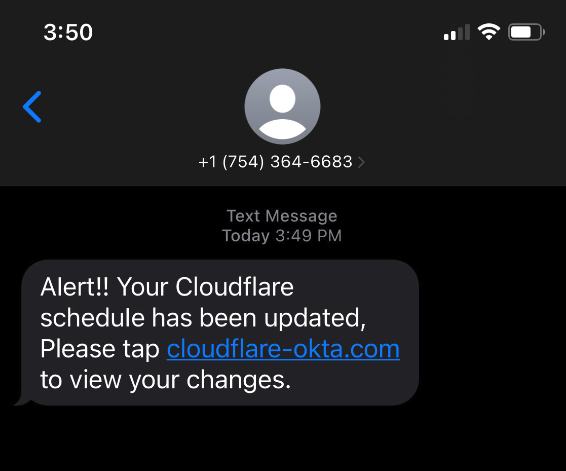
Image: Cloudflare.com
In a blog post earlier this month, Cloudflare said it detected the account takeovers and that no Cloudflare systems were compromised. Cloudflare said it does not rely on one-time passcodes as a second factor, so there was nothing to provide to the attackers. But Cloudflare said it wanted to call attention to the phishing attacks because they would probably work against most other companies.
“This was a sophisticated attack targeting employees and systems in such a way that we believe most organizations would be likely to be breached,” Cloudflare CEO Matthew Prince wrote. “On July 20, 2022, the Cloudflare Security team received reports of employees receiving legitimate-looking text messages pointing to what appeared to be a Cloudflare Okta login page. The messages began at 2022-07-20 22:50 UTC. Over the course of less than 1 minute, at least 76 employees received text messages on their personal and work phones. Some messages were also sent to the employees family members.”
On three separate occasions, the phishers targeted employees at Twilio.com, a San Francisco based company that provides services for making and receiving text messages and phone calls. It’s unclear how many Twilio employees received the SMS phishes, but the data suggest at least four Twilio employees responded to a spate of SMS phishing attempts on July 27, Aug. 2, and Aug. 7.
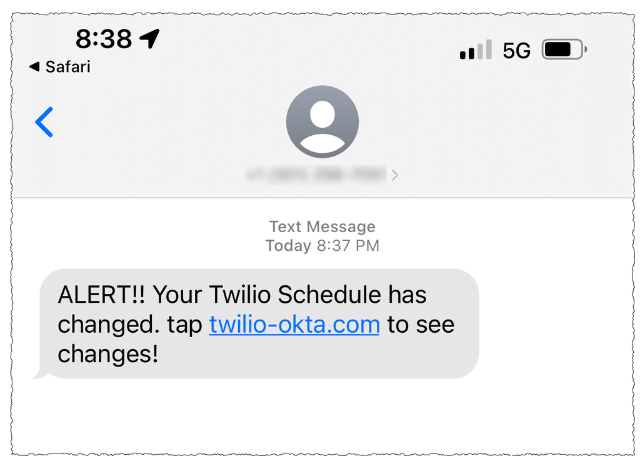
On that last date, Twilio disclosed that on Aug. 4 it became aware of unauthorized access to information related to a limited number of Twilio customer accounts through a sophisticated social engineering attack designed to steal employee credentials.
“This broad based attack against our employee base succeeded in fooling some employees into providing their credentials,” Twilio said. “The attackers then used the stolen credentials to gain access to some of our internal systems, where they were able to access certain customer data.”
That “certain customer data” included information on roughly 1,900 users of the secure messaging app Signal, which relied on Twilio to provide phone number verification services. In its disclosure on the incident, Signal said that with their access to Twilio’s internal tools the attackers were able to re-register those users’ phone numbers to another device.
On Aug. 25, food delivery service DoorDash disclosed that a “sophisticated phishing attack” on a third-party vendor allowed attackers to gain access to some of DoorDash’s internal company tools. DoorDash said intruders stole information on a “small percentage” of users that have since been notified. TechCrunch reported last week that the incident was linked to the same phishing campaign that targeted Twilio.
This phishing gang apparently had great success targeting employees of all the major mobile wireless providers, but most especially T-Mobile. Between July 10 and July 16, dozens of T-Mobile employees fell for the phishing messages and provided their remote access credentials.
“Credential theft continues to be an ongoing issue in our industry as wireless providers are constantly battling bad actors that are focused on finding new ways to pursue illegal activities like this,” T-Mobile said in a statement. “Our tools and teams worked as designed to quickly identify and respond to this large-scale smishing attack earlier this year that targeted many companies. We continue to work to prevent these types of attacks and will continue to evolve and improve our approach.”
This same group saw hundreds of responses from employees at some of the largest customer support and staffing firms, including Teleperformanceusa.com, Sitel.com and Sykes.com. Teleperformance did not respond to requests for comment. KrebsOnSecurity did hear from Christopher Knauer, global chief security officer at Sitel Group, the customer support giant that recently acquired Sykes. Knauer said the attacks leveraged newly-registered domains and asked employees to approve upcoming changes to their work schedules.
Knauer said the attackers set up the phishing domains just minutes in advance of spamming links to those domains in phony SMS alerts to targeted employees. He said such tactics largely sidestep automated alerts generated by companies that monitor brand names for signs of new phishing domains being registered.
“They were using the domains as soon as they became available,” Knauer said. “The alerting services don’t often let you know until 24 hours after a domain has been registered.”
On July 28 and again on Aug. 7, several employees at email delivery firm Mailchimp provided their remote access credentials to this phishing group. According to an Aug. 12 blog post, the attackers used their access to Mailchimp employee accounts to steal data from 214 customers involved in cryptocurrency and finance.
On Aug. 15, the hosting company DigitalOcean published a blog post saying it had severed ties with MailChimp after its Mailchimp account was compromised. DigitalOcean said the MailChimp incident resulted in a “very small number” of DigitalOcean customers experiencing attempted compromises of their accounts through password resets.
According to interviews with multiple companies hit by the group, the attackers are mostly interested in stealing access to cryptocurrency, and to companies that manage communications with people interested in cryptocurrency investing. In an Aug. 3 blog post from email and SMS marketing firm Klaviyo.com, the company’s CEO recounted how the phishers gained access to the company’s internal tools, and used that to download information on 38 crypto-related accounts.
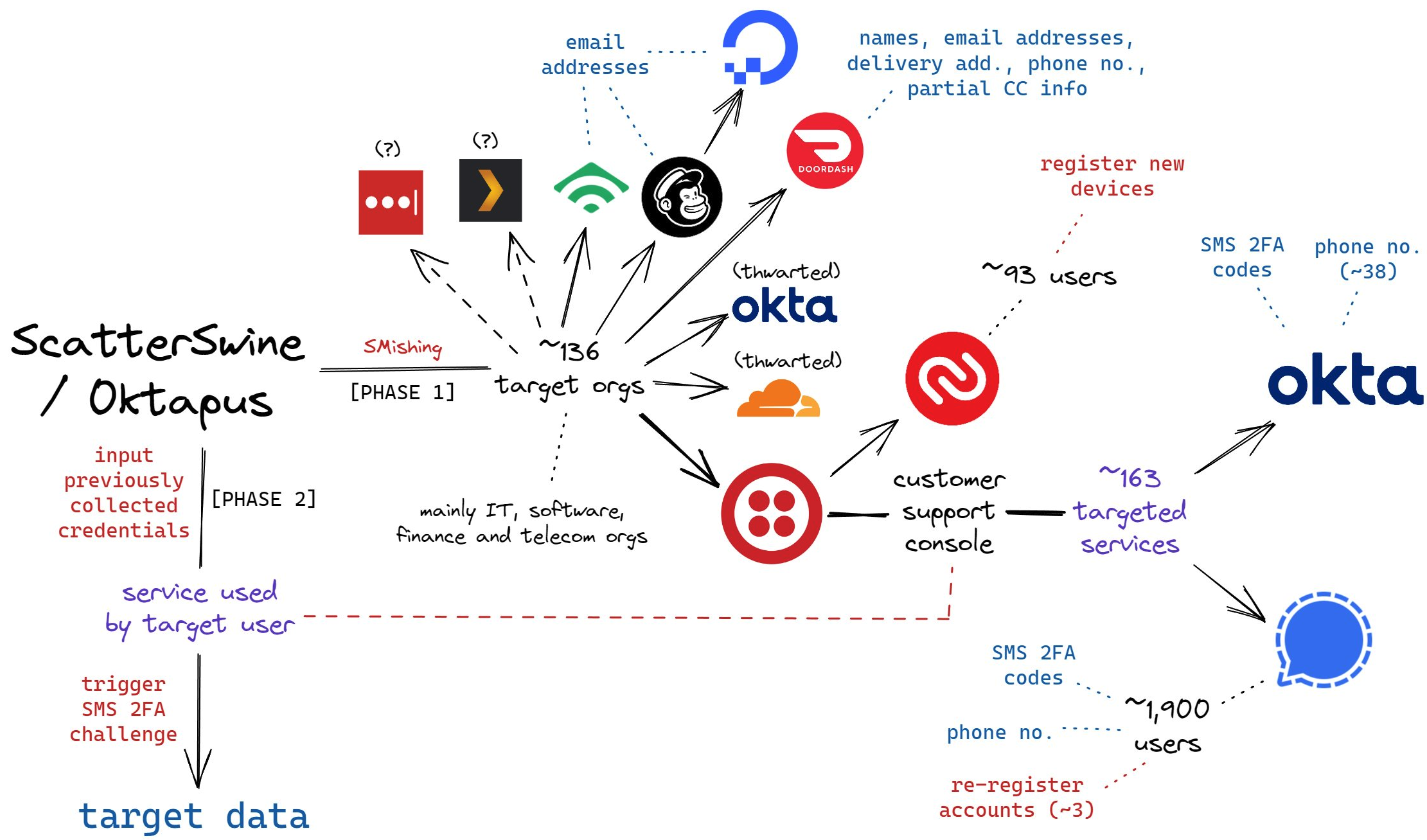
A flow chart of the attacks by the SMS phishing group known as 0ktapus and ScatterSwine. Image: Amitai Cohen for Wiz.io. twitter.com/amitaico.
The ubiquity of mobile phones became a lifeline for many companies trying to manage their remote employees throughout the Coronavirus pandemic. But these same mobile devices are fast becoming a liability for organizations that use them for phishable forms of multi-factor authentication, such as one-time codes generated by a mobile app or delivered via SMS.
Because as we can see from the success of this phishing group, this type of data extraction is now being massively automated, and employee authentication compromises can quickly lead to security and privacy risks for the employer’s partners or for anyone in their supply chain.
Unfortunately, a great many companies still rely on SMS for employee multi-factor authentication. According to a report this year from Okta, 47 percent of workforce customers deploy SMS and voice factors for multi-factor authentication. That’s down from 53 percent that did so in 2018, Okta found.
Some companies (like Knauer’s Sitel) have taken to requiring that all remote access to internal networks be managed through work-issued laptops and/or mobile devices, which are loaded with custom profiles that can’t be accessed through other devices.
Others are moving away from SMS and one-time code apps and toward requiring employees to use physical FIDO multi-factor authentication devices such as security keys, which can neutralize phishing attacks because any stolen credentials can’t be used unless the phishers also have physical access to the user’s security key or mobile device.
This came in handy for Twitter, which announced last year that it was moving all of its employees to using security keys, and/or biometric authentication via their mobile device. The phishers’ Telegram bot reported that on June 16, 2022, five employees at Twitter gave away their work credentials. In response to questions from KrebsOnSecurity, Twitter confirmed several employees were relieved of their employee usernames and passwords, but that its security key requirement prevented the phishers from abusing that information.
Twitter accelerated its plans to improve employee authentication following the July 2020 security incident, wherein several employees were phished and relieved of credentials for Twitter’s internal tools. In that intrusion, the attackers used Twitter’s tools to hijack accounts for some of the world’s most recognizable public figures, executives and celebrities — forcing those accounts to tweet out links to bitcoin scams.
“Security keys can differentiate legitimate sites from malicious ones and block phishing attempts that SMS 2FA or one-time password (OTP) verification codes would not,” Twitter said in an Oct. 2021 post about the change. “To deploy security keys internally at Twitter, we migrated from a variety of phishable 2FA methods to using security keys as our only supported 2FA method on internal systems.”
Update, 6:02 p.m. ET: Clarified that Cloudflare does not rely on TOTP (one-time multi-factor authentication codes) as a second factor for employee authentication.
Scammers are using invoices sent through PayPal.com to trick recipients into calling a number to dispute a pending charge. The missives — which come from Paypal.com and include a link at Paypal.com that displays an invoice for the supposed transaction — state that the user’s account is about to be charged hundreds of dollars. Recipients who call the supplied toll-free number to contest the transaction are soon asked to download software that lets the scammers assume remote control over their computer.
KrebsOnSecurity recently heard from a reader who received an email from paypal.com that he immediately suspected was phony. The message’s subject read, “Billing Department of PayPal updated your invoice.”
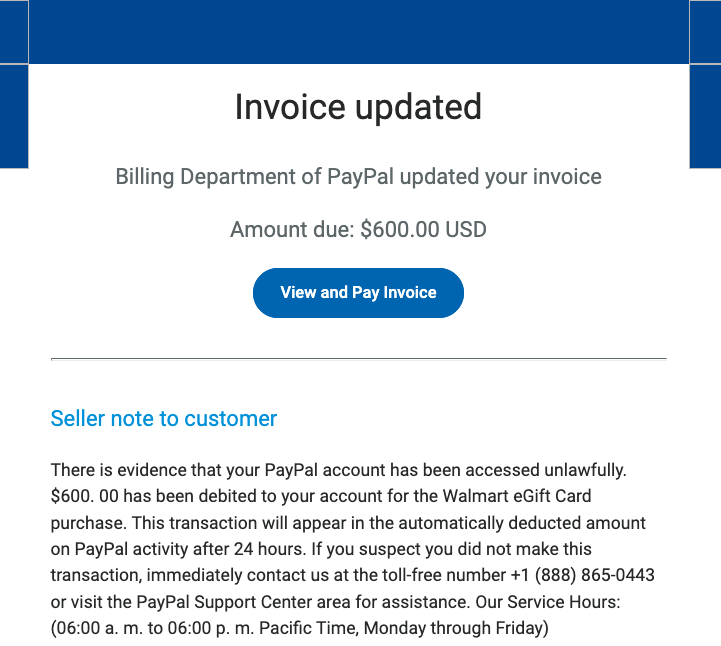
A copy of the phishing message included in the PayPal.com invoice.
While the phishing message attached to the invoice is somewhat awkwardly worded, there are many convincing aspects of this hybrid scam. For starters, all of the links in the email lead to paypal.com. Hovering over the “View and Pay Invoice” button shows the button indeed wants to load a link at paypal.com, and clicking that link indeed brings up an active invoice at paypal.com.
Also, the email headers in the phishing message (PDF) show that it passed all email validation checks as being sent by PayPal, and that it was sent through an Internet address assigned to PayPal.
Both the email and the invoice state that “there is evidence that your PayPal account has been accessed unlawfully.” The message continues:
“$600.00 has been debited to your account for the Walmart Gift Card purchase. This transaction will appear in the automatically deducted amount on PayPal activity after 24 hours. If you suspect you did not make this transaction, immediately contact us at the toll-free number….”
Here’s the invoice that popped up when the “View and Pay Invoice” button was clicked:
The reader who shared this phishing email said he logged into his PayPal account and could find no signs of the invoice in question. A call to the toll-free number listed in the invoice was received by a man who answered the phone as generic “customer service,” instead of trying to spoof PayPal or Walmart. Very quickly into the conversation he suggested visiting a site called globalquicksupport[.]com to download a remote administration tool. It was clear then where the rest of this call was going.
I can see this scam tricking a great many people, especially since both the email and invoice are sent through PayPal’s systems — which practically guarantees that the message will be successfully delivered. The invoices appear to have been sent from a compromised or fraudulent PayPal Business account, which allows users to send invoices like the one shown above. Details of this scam were shared Wednesday with PayPal’s anti-abuse (phishing@paypal.com) and media relations teams.
PayPal said in a written statement that phishing attempts are common and can take many forms.
“We have a zero-tolerance policy on our platform for attempted fraudulent activity, and our teams work tirelessly to protect our customers,” PayPal said. “We are aware of this well-known phishing scam and have put additional controls in place to mitigate this specific incident. Nonetheless, we encourage customers to always be vigilant online and to contact Customer Service directly if they suspect they are a target of a scam.”
It’s remarkable how well today’s fraudsters have adapted to hijacking the very same tools that financial institutions have long used to make their customers feel safe transacting online. It’s no accident that one of the most prolific scams going right now — the Zelle Fraud Scam — starts with a text message about an unauthorized payment that appears to come from your bank. After all, financial institutions have spent years encouraging customers to sign up for mobile alerts via SMS about suspicious transactions, and to expect the occasional inbound call about possibly fraudulent transactions.
Also, today’s scammers are less interested in stealing your PayPal login than they are in phishing your entire computer and online life with remote administration software, which seems to be the whole point of so many scams these days. Because why rob just one online account when you can plunder them all?
The best advice to sidestep phishing scams is to avoid clicking on links that arrive unbidden in emails, text messages and other mediums. Most phishing scams invoke a temporal element that warns of dire consequences should you fail to respond or act quickly. If you’re unsure whether the message is legitimate, take a deep breath and visit the site or service in question manually — ideally, using a browser bookmark to avoid potential typosquatting sites.
Earlier this month, the administrator of the cybercrime forum Breached received a cease-and-desist letter from a cybersecurity firm. The missive alleged that an auction on the site for data stolen from 10 million customers of Mexico’s second-largest bank was fake news and harming the bank’s reputation. The administrator responded to this empty threat by purchasing the stolen banking data and leaking it on the forum for everyone to download.
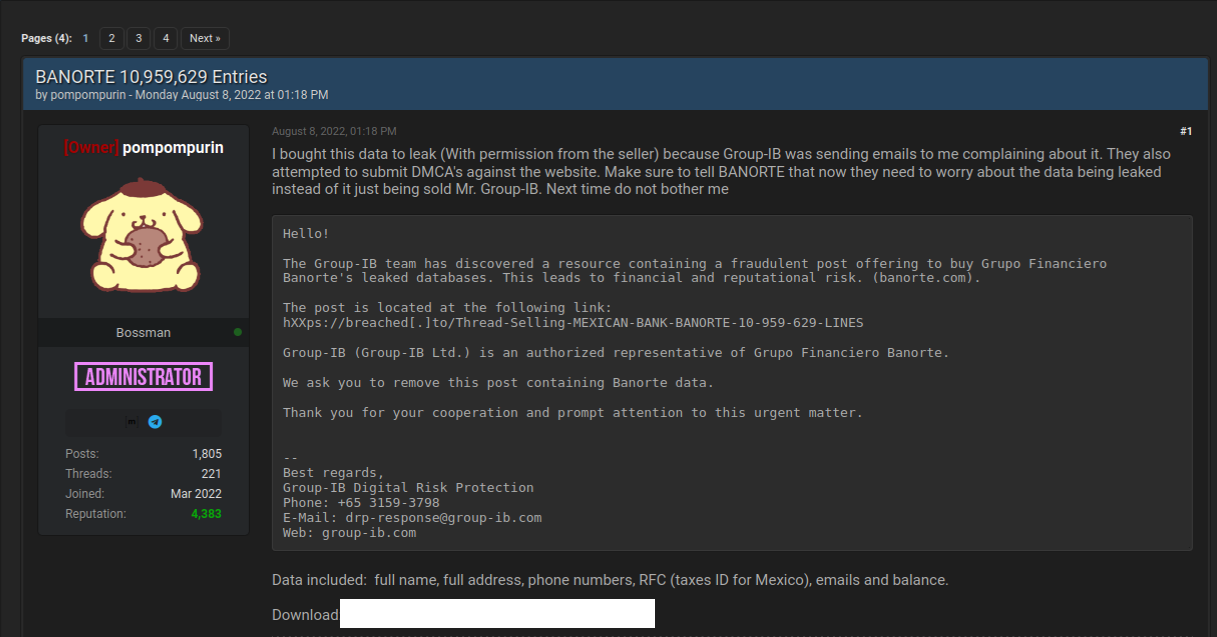
On August 3, 2022, someone using the alias “Holistic-K1ller” posted on Breached a thread selling data allegedly stolen from Grupo Financiero Banorte, Mexico’s second-biggest financial institution by total loans. Holistic-K1ller said the database included the full names, addresses, phone numbers, Mexican tax IDs (RFC), email addresses and balances on more than 10 million citizens.
There was no reason to believe Holistic-K1ller had fabricated their breach claim. This identity has been highly active on Breached and its predecessor RaidForums for more than two years, mostly selling databases from hacked Mexican entities. Last month, they sold customer information on 36 million customers of the Mexican phone company Telcel; in March, they sold 33,000 images of Mexican IDs — with the front picture and a selfie of each citizen. That same month, they also sold data on 1.4 million customers of Mexican lending platform Yotepresto.
But this history was either overlooked or ignored by Group-IB, the Singapore-based cybersecurity firm apparently hired by Banorte to help respond to the data breach.
“The Group-IB team has discovered a resource containing a fraudulent post offering to buy Grupo Financiero Banorte’s leaked databases,” reads a letter the Breach administrator said they received from Group-IB. “We ask you to remove this post containing Banorte data. Thank you for your cooperation and prompt attention to this urgent matter.”
The administrator of Breached is “Pompompurin,” the same individual who alerted this author in November 2021 to a glaring security hole in a U.S. Justice Department website that was used to spoof security alerts from the FBI. In a post to Breached on Aug. 8, Pompompurin said they bought the Banorte database from Holistic-K1ller’s sales thread because Group-IB was sending emails complaining about it.
“They also attempted to submit DMCA’s against the website,” Pompompurin wrote, referring to legal takedown requests under the Digital Millennium Copyright Act. “Make sure to tell Banorte that now they need to worry about the data being leaked instead of just being sold.”
Group-IB CEO Dmitriy Volkov said the company has seen some success in the past asking hackers to remove or take down certain information, but that making such requests is not a typical response for the security firm.
“It is not a common practice to send takedown notifications to such forums demanding that such content be removed,” Volkov said. “But these abuse letters are legally binding, which helps build a foundation for further steps taken by law enforcement agencies. Actions contrary to international rules in the regulated space of the Internet only lead to more severe crimes, which — as we know from the case of Raidforums — are successfully investigated and stopped by law enforcement.”
Banorte did not respond to requests for comment. But in a brief written statement picked up on Twitter, Banorte said there was no breach involving their infrastructure, and the data being sold is old.
“There has been no violation of our platforms and technological infrastructure,” Banorte said. “The set of information referred to is inaccurate and outdated, and does not put our users and customers at risk.”
That statement may be 100 percent true. Still, it is difficult to think of a better example of how not to do breach response. Banorte shrugging off this incident as a nothingburger is baffling: While it is almost certainly true that the bank balance information in the Banorte leak is now out of date, the rest of the information (tax IDs, phone numbers, email addresses) is harder to change.
“Is there one person from our community that think sending cease and desist letter to a hackers forum operator is a good idea?,” asked Ohad Zaidenberg, founder of CTI League, a volunteer emergency response community that emerged in 2020 to help fight COVID-19 related scams. “Who does it? Instead of helping, they pushed the organization from the hill.”
Kurt Seifried, director of IT for the CloudSecurityAlliance, was similarly perplexed by the response to the Banorte breach.
“If the data wasn’t real….did the bank think a cease and desist would result in the listing being removed?” Seifried wondered on Twitter. “I mean, isn’t selling breach data a worse crime usually than slander or libel? What was their thought process?”
A more typical response when a large bank suspects a breach is to approach the seller privately through an intermediary to ascertain if the information is valid and what it might cost to take it off the market. While it may seem odd to expect cybercriminals to make good on their claims to sell stolen data to only one party, removing sold stolen items from inventory is a fairly basic function of virtually all cybercriminal markets today (apart from perhaps sites that traffic in stolen identity data).
At a minimum, negotiating or simply engaging with a data seller can buy the victim organization additional time and clues with which to investigate the claim and ideally notify affected parties of a breach before the stolen data winds up online.
It is true that a large number of hacked databases put up for sale on the cybercrime underground are sold only after a small subset of in-the-know thieves have harvested all of the low-hanging fruit in the data — e.g., access to cryptocurrency accounts or user credentials that are recycled across multiple websites. And it’s certainly not unheard of for cybercriminals to go back on their word and re-sell or leak information that they have sold previously.
But companies in the throes of responding to a data security incident do themselves and customers no favors when they underestimate their adversaries, or try to intimidate cybercrooks with legal threats. Such responses generally accomplish nothing, except unnecessarily upping the stakes for everyone involved while displaying a dangerous naiveté about how the cybercrime underground works.
Update, Aug. 17, 10:32 a.m.: Thanks to a typo by this author, a request for comment sent to Group-IB was not delivered in advance of this story. The copy above has been updated to include a comment from Group-IB’s CEO.
The Department of Homeland Security (DHS) is urging states and localities to beef up security around proprietary devices that connect to the Emergency Alert System — a national public warning system used to deliver important emergency information, such as severe weather and AMBER alerts. The DHS warning came in advance of a workshop to be held this weekend at the DEFCON security conference in Las Vegas, where a security researcher is slated to demonstrate multiple weaknesses in the nationwide alert system.
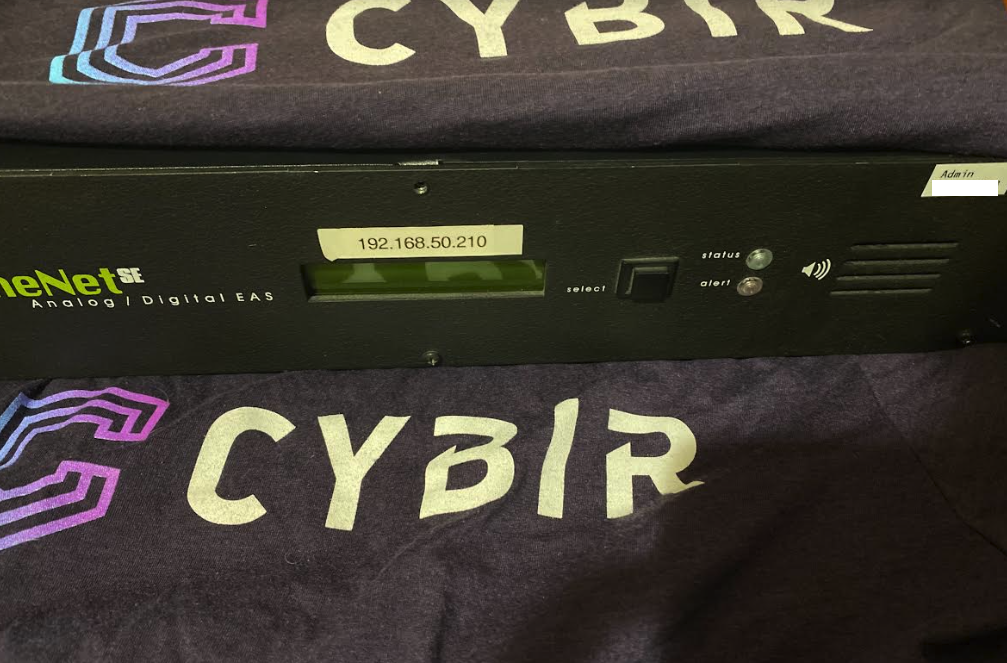
A Digital Alert Systems EAS encoder/decoder that Pyle said he acquired off eBay in 2019. It had the username and password for the system printed on the machine.
The DHS warning was prompted by security researcher Ken Pyle, a partner at security firm Cybir. Pyle said he started acquiring old EAS equipment off of eBay in 2019, and that he quickly identified a number of serious security vulnerabilities in a device that is broadly used by states and localities to encode and decode EAS alert signals.
“I found all kinds of problems back then, and reported it to the DHS, FBI and the manufacturer,” Pyle said in an interview with KrebsOnSecurity. “But nothing ever happened. I decided I wasn’t going to tell anyone about it yet because I wanted to give people time to fix it.”
Pyle said he took up the research again in earnest after an angry mob stormed the U.S. Capitol on Jan. 6, 2021.
“I was sitting there thinking, ‘Holy shit, someone could start a civil war with this thing,”’ Pyle recalled. “I went back to see if this was still a problem, and it turns out it’s still a very big problem. So I decided that unless someone actually makes this public and talks about it, clearly nothing is going to be done about it.”
The EAS encoder/decoder devices Pyle acquired were made by Lyndonville, NY-based Digital Alert Systems (formerly Monroe Electronics, Inc.), which issued a security advisory this month saying it released patches in 2019 to fix the flaws reported by Pyle, but that some customers are still running outdated versions of the device’s firmware. That may be because the patches were included in version 4 of the firmware for the EAS devices, and many older models apparently do not support the new software.
“The vulnerabilities identified present a potentially serious risk, and we believe both were addressed in software updates issued beginning Oct 2019,” EAS said in a written statement. “We also provided attribution for the researcher’s responsible disclosure, allowing us to rectify the matters before making any public statements. We are aware that some users have not taken corrective actions and updated their software and should immediately take action to update the latest software version to ensure they are not at risk. Anything lower than version 4.1 should be updated immediately. On July 20, 2022, the researcher referred to other potential issues, and we trust the researcher will provide more detail. We will evaluate and work to issue any necessary mitigations as quickly as possible.”
But Pyle said a great many EAS stakeholders are still ignoring basic advice from the manufacturer, such as changing default passwords and placing the devices behind a firewall, not directly exposing them to the Internet, and restricting access only to trusted hosts and networks.

Pyle, in a selfie that is heavily redacted because the EAS device behind him had its user credentials printed on the lid.
Pyle said the biggest threat to the security of the EAS is that an attacker would only need to compromise a single EAS station to send out alerts locally that can be picked up by other EAS systems and retransmitted across the nation.
“The process for alerts is automated in most cases, hence, obtaining access to a device will allow you to pivot around,” he said. “There’s no centralized control of the EAS because these devices are designed such that someone locally can issue an alert, but there’s no central control over whether I am the one person who can send or whatever. If you are a local operator, you can send out nationwide alerts. That’s how easy it is to do this.”
One of the Digital Alert Systems devices Pyle sourced from an electronics recycler earlier this year was non-functioning, but whoever discarded it neglected to wipe the hard drive embedded in the machine. Pyle soon discovered the device contained the private cryptographic keys and other credentials needed to send alerts through Comcast, the nation’s third-largest cable company.
“I can issue and create my own alert here, which has all the valid checks or whatever for being a real alert station,” Pyle said in an interview earlier this month. “I can create a message that will start propagating through the EAS.”
Comcast told KrebsOnSecurity that “a third-party device used to deliver EAS alerts was lost in transit by a trusted shipping provider between two Comcast locations and subsequently obtained by a cybersecurity researcher.
“We’ve conducted a thorough investigation of this matter and have determined that no customer data, and no sensitive Comcast data, were compromised,” Comcast spokesperson David McGuire said.
The company said it also confirmed that the information included on the device can no longer be used to send false messages to Comcast customers or used to compromise devices within Comcast’s network, including EAS devices.
“We are taking steps to further ensure secure transfer of such devices going forward,” McGuire said. “Separately, we have conducted a thorough audit of all EAS devices on our network and confirmed that they are updated with currently available patches and are therefore not vulnerable to recently reported security issues. We’re grateful for the responsible disclosure and to the security research community for continuing to engage and share information with our teams to make our products and technologies ever more secure. Mr. Pyle informed us promptly of his research and worked with us as we took steps to validate his findings and ensure the security of our systems.”

The user interface for an EAS device.
Unauthorized EAS broadcast alerts have happened enough that there is a chronicle of EAS compromises over at fandom.com. Thankfully, most of these incidents have involved fairly obvious hoaxes.
According to the EAS wiki, in February 2013, hackers broke into the EAS networks in Great Falls, Mt. and Marquette, Mich. to broadcast an alert that zombies had risen from their graves in several counties. In Feb. 2017, an EAS station in Indiana also was hacked, with the intruders playing the same “zombies and dead bodies” audio from the 2013 incidents.
“On February 20 and February 21, 2020, Wave Broadband’s EASyCAP equipment was hacked due to the equipment’s default password not being changed,” the Wiki states. “Four alerts were broadcasted, two of which consisted of a Radiological Hazard Warning and a Required Monthly Test playing parts of the Hip Hop song Hot by artist Young Thug.”
In January 2018, Hawaii sent out an alert to cell phones, televisions and radios, warning everyone in the state that a missile was headed their way. It took 38 minutes for Hawaii to let people know the alert was a misfire, and that a draft alert was inadvertently sent. The news video clip below about the 2018 event in Hawaii does a good job of walking through how the EAS works.

Image: Shutterstock.
A cybersecurity firm says it has intercepted a large, unique stolen data set containing the names, addresses, email addresses, phone numbers, Social Security Numbers and dates of birth on nearly 23 million Americans. The firm’s analysis of the data suggests it corresponds to current and former customers of AT&T. The telecommunications giant stopped short of saying the data wasn’t theirs, but it maintains the records do not appear to have come from its systems and may be tied to a previous data incident at another company.
Milwaukee-based cybersecurity consultancy Hold Security said it intercepted a 1.6 gigabyte compressed file on a popular dark web file-sharing site. The largest item in the archive is a 3.6 gigabyte file called “dbfull,” and it contains 28.5 million records, including 22.8 million unique email addresses and 23 million unique SSNs. There are no passwords in the database.
Hold Security founder Alex Holden said a number of patterns in the data suggest it relates to AT&T customers. For starters, email addresses ending in “att.net” accounted for 13.7 percent of all addresses in the database, with addresses from SBCGLobal.net and Bellsouth.net — both AT&T companies — making up another seven percent. In contrast, Gmail users made up more than 30 percent of the data set, with Yahoo addresses accounting for 24 percent. More than 10,000 entries in the database list “none@att.com” in the email field.
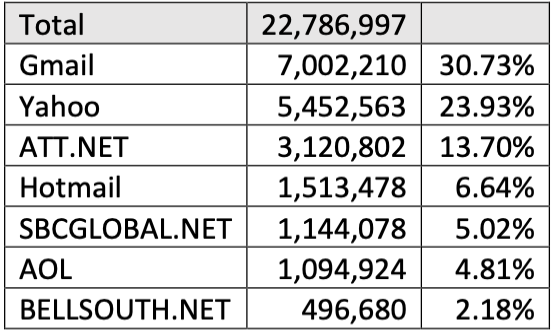
Hold Security found these email domains account for 87% of all domains in the data set. Nearly 21% belonged to AT&T customers.
Holden’s team also examined the number of email records that included an alias in the username portion of the email, and found 293 email addresses with plus addressing. Of those, 232 included an alias that indicated the customer had signed up at some AT&T property; 190 of the aliased email addresses were “+att@”; 42 were “+uverse@,” an oddly specific reference to an AT&T entity that included broadband Internet. In September 2016, AT&T rebranded U-verse as AT&T Internet.
According to its website, AT&T Internet is offered in 21 states, including Alabama, Arkansas, California, Florida, Georgia, Indiana, Kansas, Kentucky, Louisiana, Michigan, Missouri, Nevada, North Carolina, Ohio, Oklahoma, Tennessee, Texas and Wisconsin. Nearly all of the records in the database that contain a state designation corresponded to those 21 states; all other states made up just 1.64 percent of the records, Hold Security found.
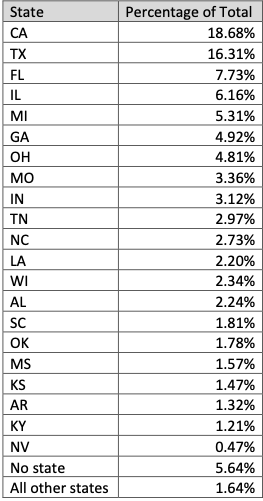
Image: Hold Security.
The vast majority of records in this database belong to consumers, but almost 13,000 of the entries are for corporate entities. Holden said 387 of those corporate names started with “ATT,” with various entries like “ATT PVT XLOW” appearing 81 times. And most of the addresses for these entities are AT&T corporate offices.
How old is this data? One clue may be in the dates of birth exposed in this database. There are very few records in this file with dates of birth after 2000.
“Based on these statistics, we see that the last significant number of subscribers born in March of 2000,” Holden told KrebsOnSecurity, noting that AT&T requires new account holders to be 18 years of age or older. “Therefore, it makes sense that the dataset was likely created close to March of 2018.”
There was also this anomaly: Holden said one of his analysts is an AT&T customer with a 13-letter last name, and that her AT&T bill has always had the same unique misspelling of her surname (they added yet another letter). He said the analyst’s name is identically misspelled in this database.
KrebsOnSecurity shared the large data set with AT&T, as well as Hold Security’s analysis of it. AT&T ultimately declined to say whether all of the people in the database are or were at some point AT&T customers. The company said the data appears to be several years old, and that “it’s not immediately possible to determine the percentage that may be customers.”
“This information does not appear to have come from our systems,” AT&T said in a written statement. “It may be tied to a previous data incident at another company. It is unfortunate that data can continue to surface over several years on the dark web. However, customers often receive notices after such incidents, and advice for ID theft is consistent and can be found online.”
The company declined to elaborate on what they meant by “a previous data incident at another company.”
But it seems likely that this database is related to one that went up for sale on a hacker forum on August 19, 2021. That auction ran with the title “AT&T Database +70M (SSN/DOB),” and was offered by ShinyHunters, a well-known threat actor with a long history of compromising websites and developer repositories to steal credentials or API keys.
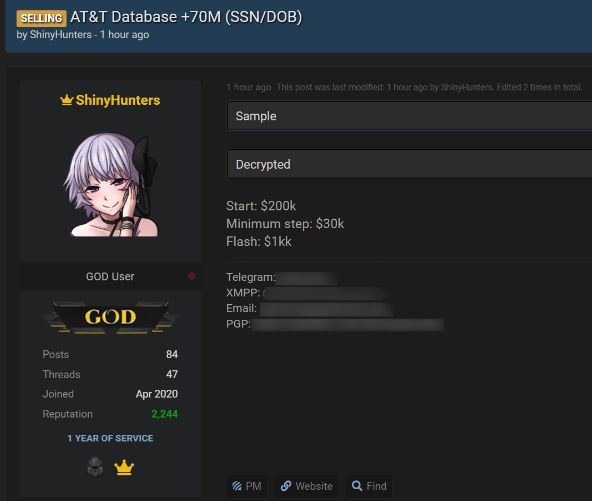
Image: BleepingComputer
ShinyHunters established the starting price for the auction at $200,000, but set the “flash” or “buy it now” price at $1 million. The auction also included a small sampling of the stolen information, but that sample is no longer available. The hacker forum where the ShinyHunters sales thread existed was seized by the FBI in April, and its alleged administrator arrested.
But cached copies of the auction, as recorded by cyber intelligence firm Intel 471, show ShinyHunters received bids of up to $230,000 for the entire database before they suspended the sale.
“This thread has been deleted several times,” ShinyHunters wrote in their auction discussion on Sept. 6, 2021. “Therefore, the auction is suspended. AT&T will be available on WHM as soon as they accept new vendors.”
The WHM initialism was a reference to the White House Market, a dark web marketplace that shut down in October 2021.
“In many cases, when a database is not sold, ShinyHunters will release it for free on hacker forums,” wrote BleepingComputer’s Lawrence Abrams, who broke the news of the auction last year and confronted AT&T about the hackers’ claims.
AT&T gave Abrams a similar statement, saying the data didn’t come from their systems.
“When asked whether the data may have come from a third-party partner, AT&T chose not to speculate,” Abrams wrote. “‘Given this information did not come from us, we can’t speculate on where it came from or whether it is valid,'” AT&T told BleepingComputer.
Asked to respond to AT&T’s denial, ShinyHunters told BleepingComputer at the time, “I don’t care if they don’t admit. I’m just selling.”
On June 1, 2022, a 21-year-old Frenchman was arrested in Morocco for allegedly being a member of ShinyHunters. Databreaches.net reports the defendant was arrested on an Interpol “Red Notice” at the request of a U.S. federal prosecutor from Washington state.
Databreaches.net suggests the warrant could be tied to a ShinyHunters theft in May 2020, when the group announced they had exfiltrated 500 GB of Microsoft’s source code from Microsoft’s private GitHub repositories.
“Researchers assess that Shiny Hunters gained access to roughly 1,200 private repositories around March 28, 2020, which have since been secured,” reads a May 2020 alert posted by the New Jersey Cybersecurity & Communications Integration Cell, a component within the New Jersey Office of Homeland Security and Preparedness.
“Though the breach was largely dismissed as insignificant, some images of the directory listing appear to contain source code for Azure, Office, and some Windows runtimes, and concerns have been raised regarding access to private API keys or passwords that may have been mistakenly included in some private repositories,” the alert continues. “Additionally, Shiny Hunters is flooding dark web marketplaces with breached databases.”
Last month, T-Mobile agreed to pay $350 million to settle a consolidated class action lawsuit over a breach in 2021 that affected 40 million current and former customers. The breach came to light on Aug. 16, 2021, when someone starting selling tens of millions of SSN/DOB records from T-Mobile on the same hacker forum where the ShinyHunters would post their auction for the claimed AT&T database just three days later.
T-Mobile has not disclosed many details about the “how” of last year’s breach, but it said the intruder(s) “leveraged their knowledge of technical systems, along with specialized tools and capabilities, to gain access to our testing environments and then used brute force attacks and other methods to make their way into other IT servers that included customer data.”
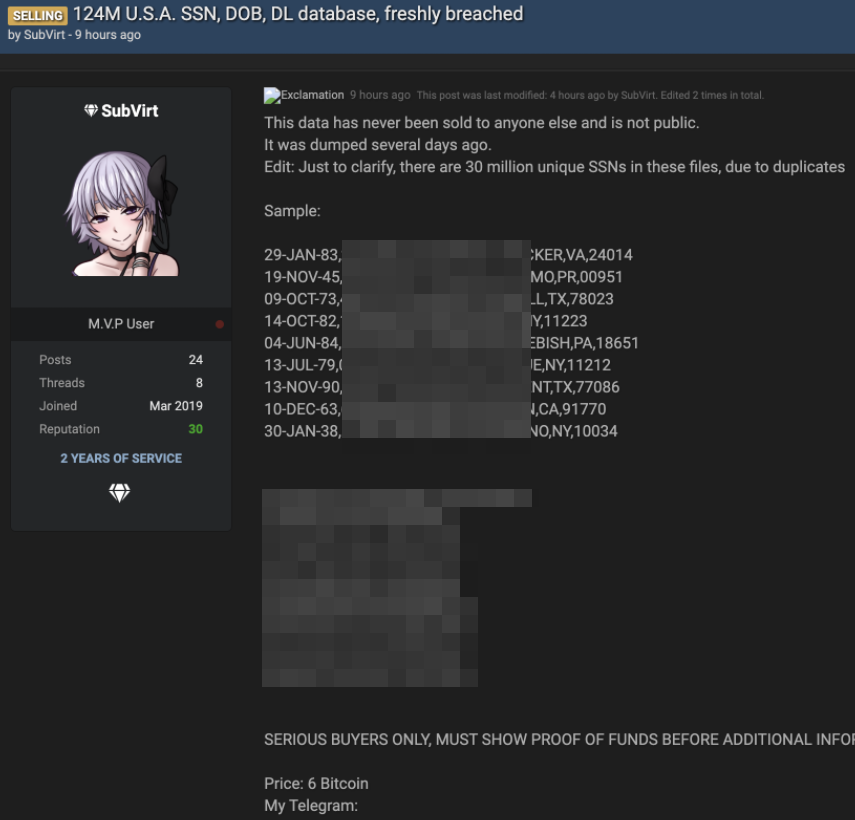
A sales thread tied to the stolen T-Mobile customer data.
One way to tame your email inbox is to get in the habit of using unique email aliases when signing up for new accounts online. Adding a “+” character after the username portion of your email address — followed by a notation specific to the site you’re signing up at — lets you create an infinite number of unique email addresses tied to the same account. Aliases can help users detect breaches and fight spam. But not all websites allow aliases, and they can complicate account recovery. Here’s a look at the pros and cons of adopting a unique alias for each website.

What is an email alias? When you sign up at a site that requires an email address, think of a word or phrase that represents that site for you, and then add that prefaced by a “+” sign just to the left of the “@” sign in your email address. For instance, if I were signing up at example.com, I might give my email address as krebsonsecurity+example@gmail.com. Then, I simply go back to my inbox and create a corresponding folder called “Example,” along with a new filter that sends any email addressed to that alias to the Example folder.
Importantly, you don’t ever use this alias anywhere else. That way, if anyone other than example.com starts sending email to it, it is reasonable to assume that example.com either shared your address with others or that it got hacked and relieved of that information. Indeed, security-minded readers have often alerted KrebsOnSecurity about spam to specific aliases that suggested a breach at some website, and usually they were right, even if the company that got hacked didn’t realize it at the time.
Alex Holden, founder of the Milwaukee-based cybersecurity consultancy Hold Security, said many threat actors will scrub their distribution lists of any aliases because there is a perception that these users are more security- and privacy-focused than normal users, and are thus more likely to report spam to their aliased addresses.
Holden said freshly-hacked databases also are often scrubbed of aliases before being sold in the underground, meaning the hackers will simply remove the aliased portion of the email address.
“I can tell you that certain threat groups have rules on ‘+*@’ email address deletion,” Holden said. “We just got the largest credentials cache ever — 1 billion new credentials to us — and most of that data is altered, with aliases removed. Modifying credential data for some threat groups is normal. They spend time trying to understand the database structure and removing any red flags.”
According to the breach tracking site HaveIBeenPwned.com, only about .03 percent of the breached records in circulation today include an alias.
Email aliases are rare enough that seeing just a few email addresses with the same alias in a breached database can make it trivial to identify which company likely got hacked and leaked said database. That’s because the most common aliases are simply the name of the website where the signup takes place, or some abbreviation or shorthand for it.
Hence, for a given database, if there are more than a handful of email addresses that have the same alias, the chances are good that whatever company or website corresponds to that alias has been hacked.
That might explain the actions of Allekabels, a large Dutch electronics web shop that suffered a data breach in 2021. Allekabels said a former employee had stolen data on 5,000 customers, and that those customers were then informed about the data breach by Allekabels.
But Dutch publication RTL Nieuws said it obtained a copy of the Allekabels user database from a hacker who was selling information on 3.6 million customers at the time, and found that the 5,000 number cited by the retailer corresponded to the number of customers who’d signed up using an alias. In essence, RTL argued, the company had notified only those most likely to notice and complain that their aliased addresses were suddenly receiving spam.
“RTL Nieuws has called more than thirty people from the database to check the leaked data,” the publication explained. “The customers with such a unique email address have all received a message from Allekabels that their data has been leaked – according to Allekabels they all happened to be among the 5000 data that this ex-employee had stolen.”
HaveIBeenPwned’s Hunt arrived at the conclusion that aliases account for about .03 percent of registered email addresses by studying the data leaked in the 2013 breach at Adobe, which affected at least 38 million users. Allekabels’s ratio of aliased users was considerably higher than Adobe’s — .14 percent — but then again European Internet users tend to be more privacy-conscious.
While overall adoption of email aliases is still quite low, that may be changing. Apple customers who use iCloud to sign up for new accounts online automatically are prompted to use Apple’s Hide My Email feature, which creates the account using a unique email address that automatically forwards to a personal inbox.
What are the downsides to using email aliases, apart from the hassle of setting them up? The biggest downer is that many sites won’t let you use a “+” sign in your email address, even though this functionality is clearly spelled out in the email standard.
Also, if you use aliases, it helps to have a reliable mnemonic to remember the alias used for each account (this is a non-issue if you create a new folder or rule for each alias). That’s because knowing the email address for an account is generally a prerequisite for resetting the account’s password, and if you can’t remember the alias you added way back when you signed up, you may have limited options for recovering access to that account if you at some point forget your password.
What about you, Dear Reader? Do you rely on email aliases? If so, have they been useful? Did I neglect to mention any pros or cons? Feel free to sound off in the comments below.
Microsoft today released updates to fix a record 141 security vulnerabilities in its Windows operating systems and related software. Once again, Microsoft is patching a zero-day vulnerability in the Microsoft Support Diagnostics Tool (MSDT), a service built into Windows. Redmond also addressed multiple flaws in Exchange Server — including one that was disclosed publicly prior to today — and it is urging organizations that use Exchange for email to update as soon as possible and to enable additional protections.

In June, Microsoft patched a vulnerability in MSDT dubbed “Follina” that had been used in active attacks for at least three months prior. This latest MSDT bug — CVE-2022-34713 — is a remote code execution flaw that requires convincing a target to open a booby-trapped file, such as an Office document. Microsoft this month also issued a different patch for another MSDT flaw, tagged as CVE-2022-35743.
The publicly disclosed Exchange flaw is CVE-2022-30134, which is an information disclosure weakness. Microsoft also released fixes for three other Exchange flaws that rated a “critical” label, meaning they could be exploited remotely to compromise the system and with no help from users. Microsoft says addressing some of the Exchange vulnerabilities fixed this month requires administrators to enable Windows Extended protection on Exchange Servers. See Microsoft’s blog post on the Exchange Server updates for more details.
“If your organization runs local exchange servers, this trio of CVEs warrant an urgent patch,” said Kevin Breen, director of cyber threat research for Immerse Labs. “Exchanges can be treasure troves of information, making them valuable targets for attackers. With CVE-2022-24477, for example, an attacker can gain initial access to a user’s host and could take over the mailboxes for all exchange users, sending and reading emails and documents. For attackers focused on Business Email Compromise this kind of vulnerability can be extremely damaging.”
The other two critical Exchange bugs are tracked as CVE-2022-24516 and CVE-2022-21980. It’s difficult to believe it’s only been a little more than a year since malicious hackers worldwide pounced in a bevy of zero-day Exchange vulnerabilities to remotely compromise the email systems for hundreds of thousands of organizations running Exchange Server locally for email. That lingering catastrophe is reminder enough that critical Exchange bugs deserve immediate attention.
The SANS Internet Storm Center‘s rundown on Patch Tuesday warns that a critical remote code execution bug in the Windows Point-to-Point Protocol (CVE-2022-30133) could become “wormable” — a threat capable of spreading across a network without any user interaction.
“Another critical vulnerability worth mentioning is an elevation of privilege affecting Active Directory Domain Services (CVE-2022-34691),” SANS wrote. “According to the advisory, ‘An authenticated user could manipulate attributes on computer accounts they own or manage, and acquire a certificate from Active Directory Certificate Services that would allow elevation of privilege to System.’ A system is vulnerable only if Active Directory Certificate Services is running on the domain. The CVSS for this vulnerability is 8.8.”
Breen highlighted a set of four vulnerabilities in Visual Studio that earned Microsoft’s less-dire “important” rating but that nevertheless could be vitally important for the security of developer systems.
“Developers are empowered with access to API keys and deployment pipelines that, if compromised, could be significantly damaging to organizations,” he said. “So it’s no surprise they are often targeted by more advanced attackers. Patches for their tools should not be overlooked. We’re seeing a continued trend of supply-chain compromise too, making it vital that we ensure developers, and their tools, are kept up-to-date with the same rigor we apply to standard updates.”
Greg Wiseman, product manager at Rapid7, pointed to an interesting bug Microsoft patched in Windows Hello, the biometric authentication mechanism for Windows 10. Microsoft notes that the successful exploitation of the weakness requires physical access to the target device, but would allow an attacker to bypass a facial recognition check.
Wiseman said despite the record number of vulnerability fixes from Redmond this month, the numbers are slightly less dire.
“20 CVEs affect their Chromium-based Edge browser and 34 affect Azure Site Recovery (up from 32 CVEs affecting that product last month),” Wiseman wrote. “As usual, OS-level updates will address a lot of these, but note that some extra configuration is required to fully protect Exchange Server this month.”
As it often does on Patch Tuesday, Adobe has also released security updates for many of its products, including Acrobat and Reader, Adobe Commerce and Magento Open Source. More details here.
Please consider backing up your system or at least your important documents and data before applying system updates. And if you run into any problems with these updates, please drop a note about it here in the comments.
A class action lawsuit has been filed against big-three consumer credit bureau Experian over reports that the company did little to prevent identity thieves from hijacking consumer accounts. The legal filing cites liberally from an investigation KrebsOnSecurity published in July, which found that identity thieves were able to assume control over existing Experian accounts simply by signing up for new accounts using the victim’s personal information and a different email address.
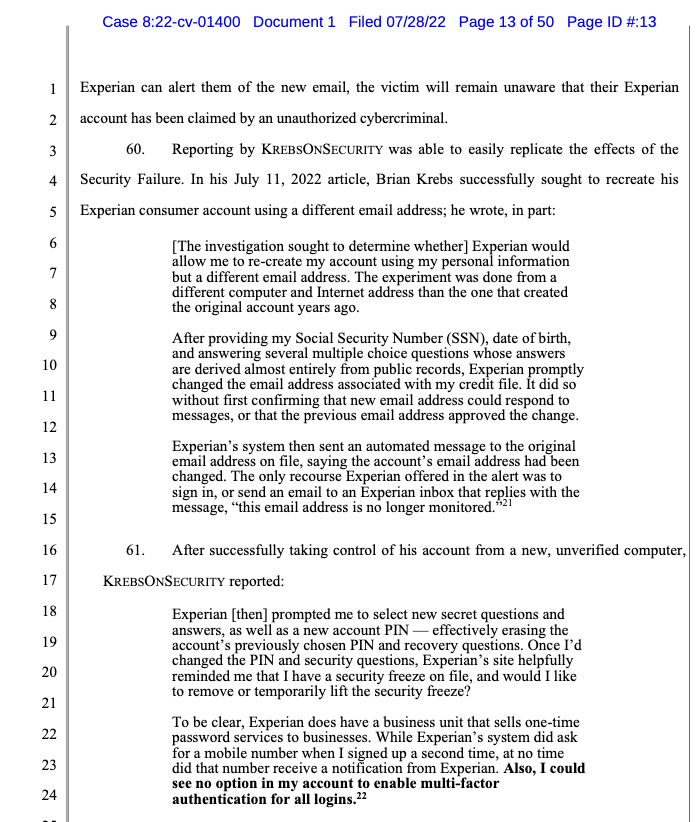
The lawsuit, filed July 28, 2022 in California Central District Court, argues that Experian’s documented practice of allowing the re-registration of accounts without first verifying that the existing account authorized the changes is a violation of the Fair Credit Reporting Act.
In July’s Experian, You Have Some Explaining to Do, we heard from two different readers who had security freezes on their credit files with Experian and who also recently received notifications from Experian that the email address on their account had been changed. So had their passwords and account PIN and secret questions. Both had used password managers to pick and store complex, unique passwords for their accounts.
Both were able to recover access to their Experian account simply by recreating it — sharing their name, address, phone number, social security number, date of birth, and successfully gleaning or guessing the answers to four multiple choice questions that are almost entirely based on public records (or else information that is not terribly difficult to find).
Here’s the bit from that story that got excerpted in the class action lawsuit:
KrebsOnSecurity sought to replicate Turner and Rishi’s experience — to see if Experian would allow me to re-create my account using my personal information but a different email address. The experiment was done from a different computer and Internet address than the one that created the original account years ago.
After providing my Social Security Number (SSN), date of birth, and answering several multiple choice questions whose answers are derived almost entirely from public records, Experian promptly changed the email address associated with my credit file. It did so without first confirming that new email address could respond to messages, or that the previous email address approved the change.
Experian’s system then sent an automated message to the original email address on file, saying the account’s email address had been changed. The only recourse Experian offered in the alert was to sign in, or send an email to an Experian inbox that replies with the message, “this email address is no longer monitored.”
After that, Experian prompted me to select new secret questions and answers, as well as a new account PIN — effectively erasing the account’s previously chosen PIN and recovery questions. Once I’d changed the PIN and security questions, Experian’s site helpfully reminded me that I have a security freeze on file, and would I like to remove or temporarily lift the security freeze?
To be clear, Experian does have a business unit that sells one-time password services to businesses. While Experian’s system did ask for a mobile number when I signed up a second time, at no time did that number receive a notification from Experian. Also, I could see no option in my account to enable multi-factor authentication for all logins.
In response to my story, Experian suggested the reports from readers were isolated incidents, and that the company does all kinds of things it can’t talk about publicly to prevent bad people from abusing its systems.
“We believe these are isolated incidents of fraud using stolen consumer information,” Experian’s statement reads. “Specific to your question, once an Experian account is created, if someone attempts to create a second Experian account, our systems will notify the original email on file.”
“We go beyond reliance on personally identifiable information (PII) or a consumer’s ability to answer knowledge-based authentication questions to access our systems,” the statement continues. “We do not disclose additional processes for obvious security reasons; however, our data and analytical capabilities verify identity elements across multiple data sources and are not visible to the consumer. This is designed to create a more positive experience for our consumers and to provide additional layers of protection. We take consumer privacy and security seriously, and we continually review our security processes to guard against constant and evolving threats posed by fraudsters.”
That sounds great, but since that story ran I’ve heard from several more readers who were doing everything right and still had their Experian accounts hijacked, with little left to show for it except an email alert from Experian saying they had changed the address on file for the account.
I’d like to believe this class action lawsuit will change things, but I do not. Likely, the only thing that will come from this lawsuit — if it is not dismissed outright — is a fat payout for the plaintiffs’ attorneys and “free” credit monitoring for a few years compliments of Experian.
Credit bureaus do not view consumers as customers, who are instead the product that is being sold to third party companies. Often that data is sold based on the interests of the entity purchasing the data, wherein consumer records can be packaged into categories like “dog owner,” “expectant parent,” or “diabetes patient.”
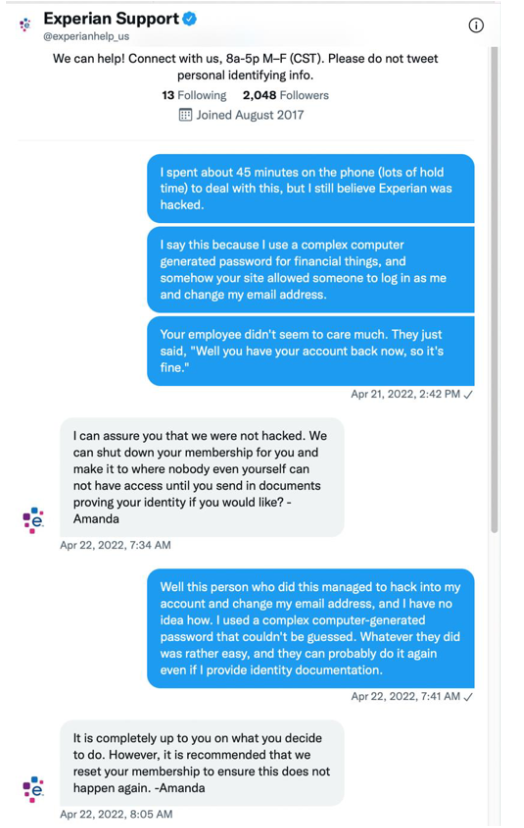
A chat conversation between the plaintiff and Experian’s support staff shows he experienced the same account hijack as described by our readers, despite his use of a computer-generated, unique password for his Experian account.
Most lenders rely on the big-three consumer credit reporting bureaus, including Equifax, Experian and Trans Union — to determine everyone’s credit score, fluctuations in which can make or break one’s application for a loan or job.
On Tuesday, The Wall Street Journal broke a story saying Equifax sent lenders incorrect credit scores for millions of consumers this spring.
Meanwhile, the credit bureaus keep enjoying record earnings. For its part, Equifax reported a record fourth quarter 2021 revenue of 1.3 billion. Much of that revenue came from its Workforce Solutions business, which sells information about consumer salary histories to a variety of customers.
The Biden administration reportedly wants to create a public entity within the Consumer Financial Protection Bureau (CFPB) that would incorporate factors like rent and utility payments into lending decisions. Such a move would require congressional approval but CFPB officials are already discussing how it might be set up, Reuters reported.
“Credit reporting firms oppose the move, saying they are already working to provide fair and affordable credit to all consumers,” Reuters wrote. “A public credit bureau would be bad for consumers because it would expand the government’s power in an inappropriate way and its goals would shift with political winds, the Consumer Data Industry Association (CDIA), which represents private rating firms, said in a statement.”
A public credit bureau is likely to meet fierce resistance from the Congress’s most generous constituents — the banking industry — which detests rapid change and is heavily reliant on the credit bureaus.
And there is a preview of that fight going on right now over the bipartisan American Data Privacy and Protection Act, which The Hill described as one of the most lobbied bills in Congress. The idea behind the bill is that companies can’t collect any more information from you than they need to provide you with the service you’re seeking.
“The bipartisan bill, which represents a breakthrough for lawmakers after years of negotiations, would restrict the kind of data companies can collect from online users and the ways they can use that data,” The Hill reported Aug. 3. “Its provisions would impact companies in every consumer-centric industry — including retailers, e-commerce giants, telecoms, credit card companies and tech firms — that compile massive amounts of user data and rely on targeted ads to attract customers.”
According to the Electronic Frontier Foundation, a nonprofit digital rights group, the bill as drafted falls short in protecting consumers in several areas. For starters, it would override or preempt many kinds of state privacy laws. The EFF argues the bill also would block the Federal Communications Commission (FCC) from enforcing federal privacy laws that now apply to cable and satellite TV, and that consumers should still be allowed to sue companies that violate their privacy.
A copy of the class action complaint against Experian is available here (PDF).

Email scammers sent an Uber to the home of an 80-year-old woman who responded to a well-timed email scam, in a bid to make sure she went to the bank and wired money to the fraudsters. In this case, the woman figured out she was being scammed before embarking for the bank, but her story is a chilling reminder of how far crooks will go these days to rip people off.
Travis Hardaway is a former music teacher turned app developer from Towson, Md. Hardaway said his mother last month replied to an email she received regarding an appliance installation from BestBuy/GeekSquad. Hardaway said the timing of the scam email couldn’t have been worse: His mom’s dishwasher had just died, and she’d paid to have a new one delivered and installed.
“I think that’s where she got confused, because she thought the email was about her dishwasher installation,” Hardaway told KrebsOnSecurity.
Hardaway said his mom initiated a call to the phone number listed in the phony BestBuy email, and that the scammers told her she owed $160 for the installation, which seemed right at the time. Then the scammers asked her to install remote administration software on her computer so that they could control the machine from afar and assist her in making the payment.
After she logged into her bank and savings accounts with scammers watching her screen, the fraudster on the phone claimed that instead of pulling $160 out of her account, they accidentally transferred $160,000 to her account. They said they they needed her help to make sure the money was “returned.”
“They took control of her screen and said they had accidentally transferred $160,000 into her account,” Hardaway said. “The person on the phone told her he was going to lose his job over this transfer error, that he didn’t know what to do. So they sent her some information about where to wire the money, and asked her to go to the bank. But she told them, ‘I don’t drive,’ and they told her, “No problem, we’re sending an Uber to come help you to the bank.'”
Hardaway said he was out of town when all this happened, and that thankfully his mom eventually grew exasperated and gave up trying to help the scammers.
“They told her they were sending an Uber to pick her up and that it was on its way,” Hardaway said. “I don’t know if the Uber ever got there. But my mom went over to the neighbor’s house and they saw it for what it was — a scam.”
Hardaway said he has since wiped her computer, reinstalled the operating system and changed her passwords. But he says the incident has left his mom rattled.
“She’s really second-guessing herself now,” Hardaway said. “She’s not computer-savvy, and just moved down here from Boston during COVID to be near us, but she’s living by herself and feeling isolated and vulnerable, and stuff like this doesn’t help.”
According to the Federal Bureau of Investigation (FBI), seniors are often targeted because they tend to be trusting and polite. More importantly, they also usually have financial savings, own a home, and have good credit—all of which make them attractive to scammers.
“Additionally, seniors may be less inclined to report fraud because they don’t know how, or they may be too ashamed of having been scammed,” the FBI warned in May. “They might also be concerned that their relatives will lose confidence in their abilities to manage their own financial affairs. And when an elderly victim does report a crime, they may be unable to supply detailed information to investigators.”
In 2021, more than 92,000 victims over the age of 60 reported losses of $1.7 billion to the FBI’s Internet Crime Complaint Center (IC3). The FBI says that represents a 74 percent increase in losses over losses reported in 2020.
The abuse of ride-sharing services to scam the elderly is not exactly new. Authorities in Tampa, Fla. say they’re investigating an incident from December 2021 where fraudsters who’d stolen $700,000 from elderly grandparents used Uber rides to pick up bundles of cash from their victims.
With the recent demise of several popular “proxy” services that let cybercriminals route their malicious traffic through hacked PCs, there is now something of a supply chain crisis gripping the underbelly of the Internet. Compounding the problem, several remaining malware-based proxy services have chosen to block new registrations to avoid swamping their networks with a sudden influx of customers.

Last week, a seven-year-old proxy service called 911[.]re abruptly announced it was permanently closing after a cybersecurity breach allowed unknown intruders to trash its servers and delete customer data and backups. 911 was already akin to critical infrastructure for many in the cybercriminal community after its top two competitors — VIP72 and LuxSocks — closed or were shut down by authorities over the past 10 months.
The underground cybercrime forums are now awash in pleas from people who are desperately seeking a new supplier of abundant, cheap, and reliably clean proxies to restart their businesses. The consensus seems to be that those days are now over, and while there are many smaller proxy services remaining, few of them on their own are capable of absorbing anywhere near the current demand.
“Everybody is looking for an alternative, bro,” wrote a BlackHatForums user on Aug. 1 in response to one of many “911 alternative” discussion threads. “No one knows an equivalent alternative to 911[.]re. Their service in terms of value and accessibility compared to other proxy providers was unmatched. Hopefully someone comes with a great alternative to 911[.]re.”
Among the more frequently recommended alternatives to 911 is SocksEscort[.]com, a malware-based proxy network that has been in existence since at least 2010. Here’s what part of their current homepage looks like:
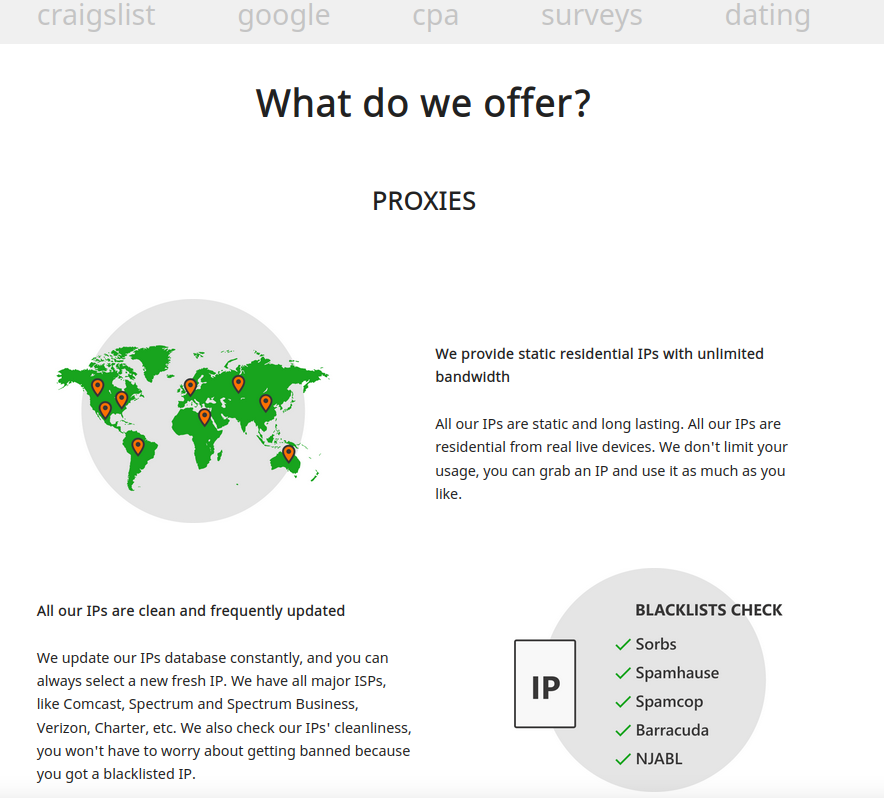
The SocksEscort home page says its services are perfect for people involved in automated online activity that often results in IP addresses getting blocked or banned, such as Craigslist and dating scams, search engine results manipulation, and online surveys.
But faced with a deluge of new signups in the wake of 911’s implosion, SocksEscort was among the remaining veteran proxy services that opted to close its doors to new registrants, replacing its registration page with the message:
“Due to unusual high demand, and heavy load on our servers, we had to block all new registrations. We won’t be able to support our proxies otherwise, and close SocksEscort as a result. We will resume registrations right after demand drops. Thank you for understanding, and sorry for the inconvenience.”
According to Spur.us, a startup that tracks proxy services, SocksEscort is a malware-based proxy offering, which means the machines doing the proxying of traffic for SocksEscort customers have been infected with malicious software that turns them into a traffic relay.
Spur says SocksEscort’s proxy service relies on software designed to run on Windows computers, and is currently leasing access to more than 14,000 hacked computers worldwide. That is a far cry from the proxy inventory advertised by 911, which stood at more than 200,000 IP addresses for rent just a few days ago.
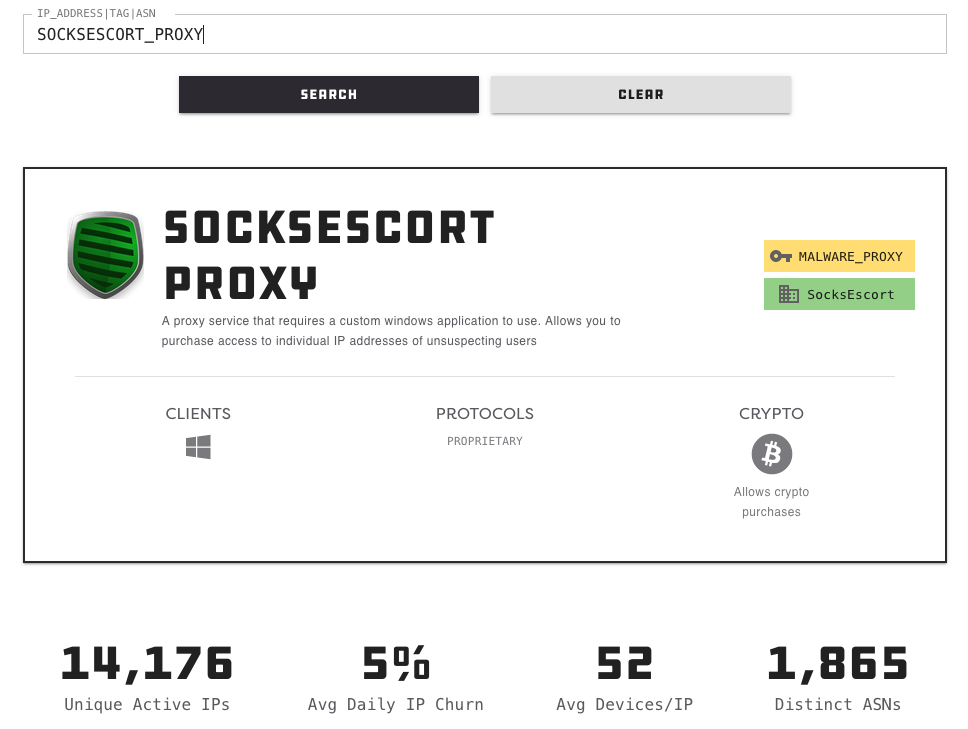
Image: Spur.us
SocksEscort is what’s known as a “SOCKS Proxy” service. The SOCKS (or SOCKS5) protocol allows Internet users to channel their Web traffic through a proxy server, which then passes the information on to the intended destination. From a website’s perspective, the traffic of the proxy network customer appears to originate from a rented/malware-infected PC tied to a residential ISP customer, not from the proxy service customer.
These services can be used in a legitimate manner for several business purposes — such as price comparisons or sales intelligence — but they are massively abused for hiding cybercrime activity because they make it difficult to trace malicious traffic to its original source.
The disruption at 911[.]re came days after KrebsOnSecurity published an in-depth look at the long-running proxy service, which showed that 911 had a history of incentivizing the installation of its proxy software without user notice or consent, and that it actually ran some of these “pay-per-install” schemes on its own to guarantee a steady supply of freshly-hacked PCs.
More on SocksEscort in an upcoming story.
Further reading:
July 29, 2022: 911 Proxy Service Implodes After Disclosing Breach
July 28, 2022: Breach Exposes Users of Microleaves Proxy Service
July 18, 2022: A Deep Dive Into the Residential Proxy Service ‘911’
June 28, 2022: The Link Between AWM Proxy & the Glupteba Botnet
June 22, 2022: Meet the Administrators of the RSOCKS Proxy Botnet
Sept. 1, 2021: 15-Year-Old Malware Proxy Network VIP72 Goes Dark

The 911 service as it existed until July 28, 2022.
911[.]re, a proxy service that since 2015 has sold access to hundreds of thousands of Microsoft Windows computers daily, announced this week that it is shutting down in the wake of a data breach that destroyed key components of its business operations. The abrupt closure comes ten days after KrebsOnSecurity published an in-depth look at 911 and its connections to shady pay-per-install affiliate programs that secretly bundled 911’s proxy software with other titles, including “free” utilities and pirated software.
911[.]re is was one of the original “residential proxy” networks, which allow someone to rent a residential IP address to use as a relay for his/her Internet communications, providing anonymity and the advantage of being perceived as a residential user surfing the web.
Residential proxy services are often marketed to people seeking the ability to evade country-specific blocking by the major movie and media streaming providers. But some of them — like 911 — build their networks in part by offering “free VPN” or “free proxy” services that are powered by software which turns the user’s PC into a traffic relay for other users. In this scenario, users indeed get to use a free VPN service, but they are often unaware that doing so will turn their computer into a proxy that lets others use their Internet address to transact online.
From a website’s perspective, the IP traffic of a residential proxy network user appears to originate from the rented residential IP address, not from the proxy service customer. These services can be used in a legitimate manner for several business purposes — such as price comparisons or sales intelligence — but they are massively abused for hiding cybercrime activity because they can make it difficult to trace malicious traffic to its original source.
As noted in KrebsOnSecurity’s July 19 story on 911, the proxy service operated multiple pay-per-install schemes that paid affiliates to surreptitiously bundle the proxy software with other software, continuously generating a steady stream of new proxies for the service.

A cached copy of flashupdate[.]net circa 2016, which shows it was the homepage of a pay-per-install affiliate program that incentivized the silent installation of 911’s proxy software.
Within hours of that story, 911 posted a notice at the top of its site, saying, “We are reviewing our network and adding a series of security measures to prevent misuse of our services. Proxy balance top-up and new user registration are closed. We are reviewing every existing user, to ensure their usage is legit and [in] compliance with our Terms of Service.”
At this announcement, all hell broke loose on various cybercrime forums, where many longtime 911 customers reported they were unable to use the service. Others affected by the outage said it seemed 911 was trying to implement some sort of “know your customer” rules — that maybe 911 was just trying to weed out those customers using the service for high volumes of cybercriminal activity.
Then on July 28, the 911 website began redirecting to a notice saying, “We regret to inform you that we permanently shut down 911 and all its services on July 28th.”
According to 911, the service was hacked in early July, and it was discovered that someone manipulated the balances of a large number of user accounts. 911 said the intruders abused an application programming interface (API) that handles the topping up of accounts when users make financial deposits with the service.
“Not sure how did the hacker get in,” the 911 message reads. “Therefore, we urgently shut down the recharge system, new user registration, and an investigation started.”
However the intruders got in, 911 said, they managed to also overwrite critical 911[.]re servers, data and backups of that data.
“On July 28th, a large number of users reported that they could not log in the system,” the statement continues. “We found that the data on the server was maliciously damaged by the hacker, resulting in the loss of data and backups. Its [sic] confirmed that the recharge system was also hacked the same way. We were forced to make this difficult decision due to the loss of important data that made the service unrecoverable.”
Operated largely out of China, 911 was an enormously popular service across many cybercrime forums, and it became something akin to critical infrastructure for this community after two of 911’s longtime competitors — malware-based proxy services VIP72 and LuxSocks — closed their doors in the past year.
Now, many on the crime forums who relied on 911 for their operations are wondering aloud whether there are any alternatives that match the scale and utility that 911 offered. The consensus seems to be a resounding “no.”
I’m guessing we may soon learn more about the security incidents that caused 911 to implode. And perhaps other proxy services will spring up to meet what appears to be a burgeoning demand for such services at the moment, with comparatively little supply.
In the meantime, 911’s absence may coincide with a measurable (if only short-lived) reprieve in unwanted traffic to top Internet destinations, including banks, retailers and cryptocurrency platforms, as many former customers of the proxy service scramble to make alternative arrangements.
Riley Kilmer, co-founder of the proxy-tracking service Spur.us, said 911’s network will be difficult to replicate in the short run.
“My speculation is [911’s remaining competitors] are going to get a major boost in the short term, but a new player will eventually come along,” Kilmer said. “None of those are good replacements for LuxSocks or 911. However, they will all allow anyone to use them. For fraud rates, the attempts will continue but through these replacement services which should be easier to monitor and stop. 911 had some very clean IP addresses.”
911 wasn’t the only major proxy provider disclosing a breach this week tied to unauthenticated APIs: On July 28, KrebsOnSecurity reported that internal APIs exposed to the web had leaked the customer database for Microleaves, a proxy service that rotates its customers’ IP addresses every five to ten minutes. That investigation showed Microleaves — like 911 — had a long history of using pay-per-install schemes to spread its proxy software.